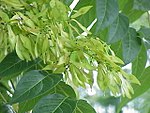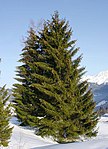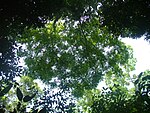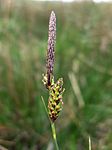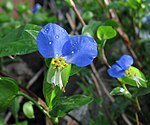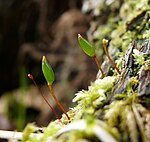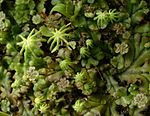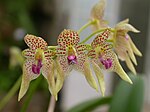Selected articles
Nominations
- Kindly look at Portal:Plants/Selected articles/Layout.
1
Adenanthos cuneatus is a shrub of the Proteaceae family, native to the south coast of Western Australia. It was originally described by French naturalist Jacques Labillardière in 1805. Within the genus Adenanthos, it lies in the section Adenanthos and is most closely related to A. stictus. A. cuneatus has hybridized with four other species of Adenanthos. Common names include Coastal Jugflower, Flame Bush, Bridle Bush and Sweat Bush. Growing to 2 m (7 ft) high and wide, it is erect to prostrate in habit, with wedge-shaped lobed leaves covered in fine silvery hair. The single red flowers are insignificant, and appear all year, though especially in late spring. The reddish new growth occurs over the summer.The shrub grows on sandy soils in heathland. Pollinators include honeyeaters, particularly the Western Spinebill, Silvereye, Honey Possum and bees. It is sensitive to Phytophthora cinnamomi dieback, and hence requires a sandy soil and good drainage to grow in cultivation. A. cuneatus is grown in gardens in Australia and the western United States, and a dwarf and prostrate form are commercially available.
2
Banksia epica is a shrub that grows on the south coast of Western Australia. A spreading bush with wedge-shaped serrated leaves and large creamy-yellow flower spikes, it grows up to 3½ metres (11½ ft) high. It is known only from two isolated populations in the remote south east of the state, near the western edge of the Great Australian Bight. Both populations occur amongst coastal heath on cliff-top dunes of siliceous sand.One of the most recently described Banksia species, it was probably seen by Edward John Eyre in 1841, but was not collected until 1973, and was only recognised as a distinct species in 1988. There has been very little research on the species since then, so knowledge of its ecology and cultivation potential is limited. It is placed in Banksia ser. Cyrtostylis, alongside its close relative, the well-known and widely cultivated B. media (Southern Plains Banksia).
3
Cicuta, commonly known as water hemlock, is a genus of four species of highly poisonous plants in the family Apiaceae. They are perennial herbaceous plants which grow up to 2.5 meters (8 ft) tall, having distinctive small green or white flowers arranged in an umbrella shape (umbel). Plants in this genus may also be referred to as cowbane or poison parsnip. Cicuta is native to temperate regions of the Northern Hemisphere, mainly North America and Europe, typically growing in wet meadows, along streambanks and other wet and marshy areas. These plants bear a close resemblance to other members in the family Apiaceae and may be confused with a number of edible or poisonous plants. The common name hemlock may also be confused with poison hemlock (Conium maculatum), or with the Hemlock tree.Water hemlock is considered one of North America's most toxic plants, being highly poisonous to humans. Three members of the genus contain a toxin named cicutoxin which causes central nervous system stimulatory effects including seizures following ingestion. Medical treatment of poisoning may include the use of activated charcoal to decrease gastrointestinal absorption of the toxic principle along with supportive care including anticonvulsant drugs such as a benzodiazepine. High doses of anticonvulsant medicine are often required to halt seizure activity and further medical care including intubation and mechanical ventilation may be required. (Full article...)
4
Verbascum thapsus (Great or Common Mullein) is a species of mullein native to Europe, northern Africa and Asia, and introduced in the Americas and Australia. It is a hairy biennial plant that can grow to 2 m tall or more. Its small yellow flowers are densely grouped on the stem, which bolts from a large rosette of leaves. It grows in a wide variety of habitats, but prefers well-lit disturbed soils, where it can appear soon after the ground receives light, from long-lived seeds that persist in the soil seed bank. It is a common weedy plant that spreads by prolifically producing seeds, but rarely becomes aggressively invasive since its seeds require open ground to germinate. It is a very minor problem for most agricultural crops since it is not a very competitive species, being intolerant of shade from other plants and unable to survive tilling. It however hosts many insects, some of which can be harmful to other plants. Although individuals are easy to remove by hand, populations are difficult to eliminate permanently. It is widely used for herbal remedies with emollient and astringent properties, and especially recommended for coughs and related problems, but also used in topical applications against a variety of skin problems. The plant was also used to make dyes and torches.
5
The durian is the fruit of trees of the genus Durio belonging to the Malvaceae, a large family which includes hibiscus, okra, cotton, mallows and linden trees. Widely known and revered in Southeast Asia as the "King of Fruits," the fruit is distinctive for its large size, unique odour, and a formidable thorn-covered husk. The fruit can grow up to 30 centimetres (12 in) long and 15 centimetres (6 in) in diameter, and typically weighs one to three kilograms (2 to 7 lb). Its shape ranges from oblong to round, the colour of its husk green to brown and its flesh pale-yellow to red, depending on species. The hard outer husk is covered with sharp, prickly thorns, while the edible flesh within emits the distinctive odour, which is regarded as either fragrant or overpowering and offensive. Even when the husk of the fruit is still intact, the odour of the ripe fruit is very strong and penetrating. This unusual odour prompted many people to search for an accurate description, with views ranging from highly appreciative to deep disgust.
6
Ailanthus altissima, commonly known as tree of heaven, ailanthus, or in Chinese as chouchun, is a deciduous tree in the quassia family (Simaroubaceae). It is native to northeast and central China as well as Taiwan. Unlike other members of the genus Ailanthus, it is found in temperate climates rather than the tropics. The tree grows rapidly and is capable of reaching heights of 15 metres (49 ft) in 25 years. However, the species is also short lived and rarely lives more than 50 years. Other common names include China sumac, copal tree, stink tree and ghetto palm.In China the tree of heaven has a long and rich history. It was mentioned in the oldest extant Chinese dictionary and listed in countless Chinese medical texts for its purported ability to cure ailments ranging from mental illness to balding. The roots, leaves and bark are still used today in traditional Chinese medicine, primarily as an astringent. The tree has been grown extensively both in China and abroad as a host plant for the ailanthus silkmoth, a moth involved in silk production. Ailanthus has become a part of western culture as well, with the tree serving as the central metaphor and subject matter of the best-selling American novel A Tree Grows in Brooklyn by Betty Smith.
7
Ficus aurea, commonly known as the Florida strangler fig (or simply strangler fig), golden fig, or higuerón, is a tree in the family Moraceae that is native to Florida, the northern and western Caribbean, southern Mexico and Central America south to Panama. The specific epithet aurea was coined by English botanist Thomas Nuttall who described the species in 1846; older names applied to this species have been ruled invalid. Ficus aurea is a strangler fig; seed germination usually takes place in the canopy of a host tree and the seedling lives as an epiphyte until its roots establish contact with the ground. It then enlarges and strangles its host, eventually becoming a freestanding tree in its own right. Individuals may reach 30 m (100 ft) in height. Like all figs, it has an obligate mutualism with fig wasps; figs are only pollinated by fig wasps, and fig wasps can only reproduce in fig flowers. The tree provides habitat, food and shelter for a host of tropical lifeforms including epiphytes in cloud forests and birds, mammals, reptiles and invertebrates. F. aurea is used in traditional medicine, for live fences, as an ornamental and as a bonsai.
8
Saffron is a spice derived from the flower of the saffron crocus (Crocus sativus), a species of crocus in the family Iridaceae. The flower has three stigmas, which are the distal ends of the plant's carpels. Together with its style, the stalk connecting the stigmas to the rest of the plant, these components are often dried and used in cooking as a seasoning and colouring agent. Saffron, which has for decades been the world's most expensive spice by weight, is native to Southwest Asia. Saffron is characterised by a bitter taste and an iodoform- or hay-like fragrance; these are caused by the chemicals picrocrocin and safranal. It also contains a carotenoid dye, crocin, that gives food a rich golden-yellow hue. These traits make saffron a much-sought ingredient in many foods worldwide. Saffron also has medicinal applications. The domesticated saffron crocus C. sativus is an autumn-flowering perennial plant unknown in the wild, and is a sterile triploid mutant of the eastern Mediterranean autumn-flowering Crocus cartwrightianus. According to botanical research, C. cartwrightianus originated in Crete, not—as was once generally believed—in Central Asia. The saffron crocus resulted when C. cartwrightianus was subjected to extensive artificial selection by growers who desired elongated stigmas. Being sterile, the saffron crocus's purple flowers fail to produce viable seeds—thus, reproduction is dependent on human assistance: the corms (underground bulb-like starch-storing organs) must be manually dug up, broken apart, and replanted. A corm survives for only one season, reproducing via division into up to ten "cormlets" that eventually give rise to new plants. The corms are small brown globules up to 4.5 centimetres (1.8 in) in diameter and are shrouded in a dense mat of parallel fibers.
9
Pinguicula moranensis is a perennial rosette-forming insectivorous herb native to Mexico and Guatemala. A species of butterwort, it forms summer rosettes of flat, succulent leaves up to 10 centimeters (4 in) long, which are covered in mucilagenous (sticky) glands that attract, trap, and digest arthropod prey. Nutrients derived from the prey are used to supplement the nutrient-poor substrate that the plant grows in. In the winter the plant forms a non-carnivorous rosette of small, fleshy leaves that conserves energy while food and moisture supplies are low. Single pink, purple, or violet flowers appear twice a year on upright stalks up to 25 centimeters long. The species was first collected by Humboldt and Bonpland on the outskirts of Mina de Morán in the Sierra de Pachuca of the modern-day Mexican state of Hidalgo on their Latin American expedition of 1799–1804. Based on these collections, Humboldt, Bonpland and Carl Sigismund Kunth described this species in Nova Genera et Species Plantarum in 1817. The extremely variable species has been redefined at least twice since, while several new species have been segregated from it based on various geographical or morphological distinctions, although the legitimacy of some of these is still debated. P. moranensis remains the most common and most widely distributed member of the Section Orcheosanthus. It has long been cultivated for its carnivorous nature and attractive flowers, and is one of the most common butterworts in cultivation.
10
Johann Georg Adam Forster (November 27, 1754 – January 10, 1794) was a German naturalist, ethnologist, travel writer, journalist, and revolutionary. At an early age, he accompanied his father on several scientific expeditions, including James Cook's second voyage to the Pacific. His report from that journey, A Voyage Round the World, contributed significantly to the ethnology of the people of Polynesia and remains a respected work among both scientists and ordinary readers. As a result of the report Forster was admitted to the Royal Society at the early age of twenty-two and came to be considered one of the founders of modern scientific travel literature. He taught natural history at the Collegium Carolinum in Kassel (1778-1784), and later at Academy of Vilna (Vilnius University) (1784–1787). He then (1788) became head librarian at the University of Mainz. Most of his scientific work during this time consisted of essays on botany and ethnology, but he also prefaced and translated many books about travels and explorations, including a German translation of Cook's diaries. Forster was a central figure of the Enlightenment in Germany, and corresponded with most of its adherents, including his close friend Georg Christoph Lichtenberg. His ideas and personality influenced Alexander von Humboldt, one of the great scientists of the 19th century. When the French took control of Mainz in 1792, Forster became one of the founders of the Jacobin Club there and went on to play a leading role in the Mainz Republic, the earliest republican state in Germany. During July 1793 and while he was in Paris as a delegate of the young Mainz Republic, Prussian and Austrian coalition forces regained control of the city and Forster was declared an outlaw. Unable to return to Germany and separated from his friends and family, he died in Paris in early 1794.
11
Nepenthes rajah is an insectivorous pitcher plant species of the monotypic Nepenthaceae family. It is endemic to Mount Kinabalu and neighbouring Mount Tambuyukon in Sabah, Malaysian Borneo. N. rajah grows exclusively on serpentine substrates at an altitude of 1500 to 2650 m a.s.l., particularly in areas of seeping ground water, where the soil is loose and permanently moist. Due to its localised distribution, N. rajah is classified as an endangered species by the IUCN and listed on CITES Appendix I. N. rajah was first collected by Hugh Low in 1858. It was described the following year by Joseph Dalton Hooker, who named it after James Brooke, the first White Rajah of Sarawak. Since being introduced into cultivation in 1881, N. rajah has always been a much sought-after species. For a long time, it was a plant seldom seen in private collections due to its rarity, price, and specialised growing requirements. Recent advances in tissue culture technology have resulted in prices falling dramatically, and N. rajah is now relatively widespread in cultivation. N. rajah has giant urn-shaped traps, which can grow up to 35 cm high and 18 cm wide. These are capable of holding 3.5 litres of water and in excess of 2.5 litres of digestive fluid, making them probably the largest in the genus by volume. Another characteristic morphological feature of N. rajah is the peltate leaf attachment of the lamina and tendril, which is present in only a few other species. N. rajah is known to occasionally trap vertebrates including small mammals. Insects, and particularly ants, comprise the majority of prey in both aerial and terrestrial pitchers.
12
Banksia spinulosa, the Hairpin Banksia, is a species of woody shrub, of the genus Banksia in the Proteaceae family, native to eastern Australia. Widely distributed, it is found as an understorey plant in open dry forest or heathland from Victoria to north Queensland, generally on sandstone though sometimes also clay soils. It generally grows as a small shrub to 2 metres (7 ft) in height, though can be a straggly tree to 6 metres (20 ft). It has long narrow leaves with inflorescences which can vary considerably in coloration; while the spikes are gold or less commonly yellowish, the emergent styles may be a wide range of colours–from black, purple, red, orange or yellow. Banksia spinulosa was named by James Edward Smith in England in 1793, after being collected by John White, most likely in 1792. He gave it the common name "Prickly-leaved Banksia", though this has fallen out of use. With four currently recognised varieties, the species has had a complicated taxonomic history, with two varieties initially described as separate species in the early 19th century. A fourth from the New England region has only recently been described. However there has been disagreement whether one, var. cunninghamii, is distinct enough to once again have specific status. The pre-eminent authority on Banksia, Alex George, concedes there is still more work to be done on the Banksia spinulosa complex.
13
The flora of Scotland is an assemblage of native plant species including over 1,600 vascular plants, more than 1,500 lichens and nearly 1,000 bryophytes. The total number of vascular species is low by world standard but lichens and bryophytes are abundant and the latter form a population of global importance. Various populations of rare fern exist, although the impact of 19th century collectors threatened the existence of several species. The flora is generally typical of the north west European part of the Palearctic ecozone and prominent features of the Scottish flora include boreal Caledonian forest (much reduced from its natural extent), heather moorland and coastal machair. There are a variety of important trees species and specimens; a Douglas Fir near Inverness is the tallest tree in the United Kingdom and the Fortingall Yew may be the oldest tree in Europe. The Shetland Mouse-ear and Scottish Primrose (pictured) are endemic flowering plants and there are a variety of endemic mosses and lichens. Conservation of the natural environment is well developed and various organisations play an important role in the stewardship of the country's flora. Numerous references to the country's flora appear in folklore, song and poetry.
14
Telopea speciosissima, commonly known as the New South Wales waratah or simply waratah, is a large shrub in the plant family Proteaceae. It is a shrub to 3 or 4 m (10–13 ft) high and 2 m (7 ft) wide, with dark green leaves. Its several stems arise from a pronounced woody base known as a lignotuber. The species is most renowned for its striking large red springtime inflorescences (flowerheads), each including hundreds of individual flowers. These are visited by the eastern pygmy possum (Cercartetus nanus), birds such as honeyeaters (Meliphagidae), and various insects.The floral emblem for its home state of New South Wales, Telopea speciosissima has featured prominently in art, architecture, and advertising, particularly since Australian federation. Commercially grown in several countries as a cut flower, it is also cultivated in home gardens, requiring good drainage yet adequate moisture, but is vulnerable to various fungal diseases and pests. A number of cultivars with various shades of red, pink and even white flowers are available. Horticulturists have also developed hybrids with T. oreades and T. mongaensis which are more tolerant of cold, shade, and heavier soils.
15
Drosera regia, commonly known as the king sundew, is a carnivorous plant in the sundew genus Drosera and is endemic to a single valley in South Africa. The genus name Drosera comes from the Greek word droseros, meaning "dew-covered". The specific epithet regia is derived from the Latin for "royal", a reference to the "striking appearance" of the species. Individual leaves can reach 70 cm (28 in) in length. It has many unusual relict characteristics not found in most other Drosera species, including woody rhizomes, operculate pollen, and the lack of circinate vernation in scape growth. All of these factors, combined with molecular data from phylogenetic analysis, contribute to the evidence that D. regia possesses some of the most ancient characteristics within the genus. Some of these are shared with the related Venus flytrap (Dionaea muscipula), which suggests a close evolutionary relationship.The tentacle-covered leaves can capture large prey, such as beetles, moths, and butterflies. The tentacles of all Drosera species are specialised stalked glands on the leaf's upper surface that produce a sticky mucilage. The leaves are considered active flypaper traps that respond to captured prey by bending to surround it. In its native fynbos habitat, the plants compete for space with native marsh grasses and low evergreen shrubs. Of the two known populations of D. regia, the higher altitude site appears to be overgrown and is essentially extirpated. The lower altitude site is estimated to have about 50 mature plants, making it the most endangered Drosera species, since it is threatened with extinction in the wild. It is often cultivated by carnivorous plant enthusiasts and a single cultivar has been registered.
16
A juniper berry is the female seed cone produced by the various species of junipers. It is not a true berry but a cone with unusually fleshy and merged scales, which give it a berry-like appearance. The cones from a handful of species, especially Juniperus communis, are used as a spice, particularly in European cuisine, and also give gin its distinguishing flavour. According to one FAO document, juniper berries are the only spice derived from conifers, though tar and inner bark (used as a sweetener by Apache cuisines) from pine trees is sometimes considered a spice as well. All juniper species grow berries, but some are considered too bitter to eat. In addition to J. communis, other edible species include Juniperus drupacea, Juniperus oxycedrus, Juniperus phoenicea, Juniperus deppeana, and Juniperus californica. Some species, for example Juniperus sabina, are toxic and consumption is inadvisable.Juniperus communis berries vary from four to twelve millimetres in diameter; other species are mostly similar in size, though some are larger, notably J. drupacea (20–28 mm). Unlike the separated and woody scales of a typical pine cone, those in a juniper berry remain fleshy and merge into a unified covering surrounding the seeds. The berries are green when young, and mature to a purple-black colour over about 18 months in most species, including J. communis (shorter, 8–10 months in a few species, and about 24 months in J. drupacea). The mature, dark berries are usually but not exclusively used in cuisine, while gin is flavoured with fully grown but immature green berries.
17
Amaranthus brownii is an annual herb in the family Amaranthaceae. The plant is found only on the small island of Nihoa in the Northwestern Hawaiian Islands, growing on rocky outcrops at altitudes of 120–215 m (394–705 ft). It is one of nine species of Amaranthus in the Hawaiian Islands, but the only endemic Hawaiian species of the genus. It was first discovered during the Tanager Expedition in 1923 by botanist Edward Leonard Caum. A. brownii differs from other Hawaiian species of Amaranthus with its spineless leaf axils, linear leaves, and indehiscent fruits.
A. brownii is considered the rarest plant on Nihoa and has not been directly observed on the island since 1983. Past expeditions collected plant samples and seeds, but no specimens have managed to survive ex-situ conservation efforts outside of its native habitat. There are no known plants or seeds from A. brownii in any botanical gardens. Conservation and recovery plans for A. brownii have been proposed by the United States Fish and Wildlife Service (FWS) which administers the island of Nihoa as part of the Hawaiian Islands National Wildlife Refuge in the Papahānaumokuākea Marine National Monument. In 1996, the plant was listed by the FWS as an endangered species. In 2003, the FWS designated the island of Nihoa as a critical habitat for the plant and it was classified as critically endangered on the IUCN Red List.
18
Old Tjikko is a 9,550 year old Norway Spruce tree, located on Fulufjället Mountain of Dalarna province in Sweden. Old Tjikko is the world's oldest living individual clonal tree, however, there are many examples of much older clonal colonies (multiple trees connected by a common root system), such as "Pando", estimated to be over 80,000 years old. The age of the tree was determined by carbon dating of the root system under the tree, not by dendrochronology, or counting tree rings. The trunk itself is estimated to be only a few hundred years old, but the tree as a whole may have survived for much longer due to a process known as layering (when a branch comes in contact with the ground, it sprouts a new root), or vegetative cloning (when the trunk dies but the root system is still alive, it may sprout a new trunk). The oldest living non-clonal tree, verified by dendrochronology, is "Methuselah" (4,800 years old), a Great Basin Bristlecone Pine in California. Vegetative cloning and reproduction is common in many plants, such as the creosote bush (see "King Clone", estimated from growth rate to be almost 12,000 years old). Many other plants also may take advantage of this process either exclusively or in tandem with sexual reproduction, but dating or estimating the age of these organisms may not be possible without evidence (e.g., old roots, ancient remains, consistent growth rates).
19
Simarouba amara is a dioecious species of tree in the Simaroubaceae family, found in the rainforests and savannahs of South and Central America and the Caribbean. It was first described by Aublet in French Guiana in 1775 and is one of six species of Simarouba. The tree is evergreen, but produces a new set of leaves once a year. It requires relatively high levels of light to grow and grows rapidly in these conditions, but lives for a relatively short time. The small yellow flowers are thought to be pollinated by insects, the resulting fruits are dispersed by animals including monkeys, birds and fruit-eating bats and the seeds are also dispersed by leaf cutter ants.The leaves of S. amara are eaten by several species of caterpillar, particularly those in the Atteva genus. Several species of termite and ants live on or around the tree and lianas and epiphytes grow on the tree. The bark of S. amara has been used by people in its range to treat dysentery and diarrhea, as well as other diseases, and was also exported to Europe in the eighteenth century to treat these illnesses. A number of compounds have since been isolated from the bark and have been shown to have antimicrobial effects. Local people use the wood of the tree for various purposes and it is also grown in plantations and harvested for its timber, some of which is exported.
20
Carex binervis, the green-ribbed sedge, is a European species of sedge with an Atlantic distribution. It is found from Fennoscandia to the Iberian Peninsula, and occurs in heaths, moorland and other damp, acidic environments. It typically grows to a height of 15–120 cm (6–50 in), and has inflorescences comprising one male and several female spikes, each up to 45 mm (1.8 in) long. The utricles have two conspicuous green veins, which give rise to both the scientific name and the common name of the species. In the vegetative state, it closely resembles C. bigelowii, a species that usually grows at higher altitude. C. binervis was first descrbed by James Edward Smith in 1800, and is classified in Carex sect. Spirostachyae; several hybrids with other Carex species are known.
21
Commelina communis, commonly known as the Asiatic dayflower, is an herbaceous annual plant in the dayflower family. It is native throughout much of East Asia and northern parts of Southeast Asia. It has also been introduced to parts of central and southeastern Europe and much of eastern North America, where it has spread to become a noxious weed. It is common in disturbed sites and in moist soil. The flowers emerge from summer through fall and are distinctive with two relatively large blue petals and one very reduced white petal.Carl Linnaeus picked the name Commelina in honour of the two Dutch botanists of the Commelijn family, using the two large showy petals of Commelina communis to symbolise them. It had been used for generations in traditional Chinese medicine. The flowers have also been used in Japan to produce a dye and a pigment that was used in many world-renowned Ukiyo-e woodcuts from the 18th and early 19th centuries. In the modern era the plant has found limited use as a model organism in the field of plant physiology due to its complex pigment chemistry and the ease of viewing its stomata.
The flowers' interactions with pollinators have been well studied and have helped to support important hypotheses about pollination in the field of plant ecology. Recent research has also revealed that the Asiatic dayflower can bioaccumulate a number of metals, making it a candidate for revegetating and essentially cleaning spoiled copper mines. Several animals and fungi use the plant as a food source, with a few species feeding upon it exclusively.
22
Datura is a genus of nine species of highly poisonous, vespertine-flowering plants belonging to the nightshade family (Solanaceae). They are commonly known as thornapples or jimsonweeds, but are also known as devil's trumpets (not to be confused with angel's trumpets, which are placed in the closely related genus Brugmansia). Other English common names include moonflower, devil's weed, and hell's bells. All species of Datura are extremely poisonous and psychoactive, especially their seeds and flowers, which can cause respiratory depression, arrhythmias, fever, delirium, hallucinations, anticholinergic syndrome, psychosis, and death if taken internally.Due to their effects and symptoms, Datura species have occasionally been used not only as poisons, but also as hallucinogens by various groups throughout history. Traditionally, their psychoactive administration has often been associated with witchcraft and sorcery or similar practices in many cultures, including the Western world. Certain common Datura species have also been used ritualistically as entheogens by some Native American groups. (Full article...)
23
Buxbaumia (bug moss, bug-on-a-stick, humpbacked elves, or elf-cap moss) is the botanical name for a genus of twelve species of moss (Bryophyta). It was named in 1801 by Johann Hedwig to commemorate Johann Christian Buxbaum, a German physician and botanist who discovered the moss in 1712 at the mouth of the Volga River.Plants of Buxbaumia have a much reduced gametophyte, bearing a sporophyte that is enormous by comparison. In most mosses, the gametophyte stage of the life cycle is both green and leafy, and is substantially larger than the spore-producing stage. Unlike these other mosses, the gametophyte of Buxbaumia is microscopic, colorless, stemless, and nearly leafless. It consists exclusively of thread-like protonemata for most of its existence, resembling a thin green-black felt on the surface where it grows. The plants are dioicous, with separate plants producing the male and female organs. Male plants develop only one microscopic leaf around each antheridium, and female plants produce just three or four tiny colorless leaves around each archegonium. Because of its small size, the gametophyte stage is not generally noticed until the stalked sporangium develops, and is locatable principally because the sporangium grows upon and above the tiny gametophyte. The extremely reduced state of Buxbaumia plants raises the question of how it makes or obtains sufficient nutrition for survival. In contrast to most mosses, Buxbaumia does not produce abundant chlorophyll and is saprophytic.
24
Attalea is a large genus of palms native to Mexico, the Caribbean, Central and South America. This pinnately leaved, non-spiny genus includes both small palms lacking an aboveground stem and large trees. The genus has a complicated taxonomic history, and has often been split into four or five genera based on differences in the male flowers. Since the genera can only be distinguished on the basis of their male flowers, the existence of intermediate flower types and the existence of hybrids between different genera has been used as an argument for keeping them all in the same genus. This has been supported by a recent molecular phylogeny.Somewhere between 29 and 67 species are recognised in the genus, with estimates of as many as 100. Incomplete herbarium collections make it difficult to determine whether certain groups represent single species, or groups of similar species. Attalea species have a long history of human use, and include economically important sources of palm oil and fibre. Many species are fire tolerant and thrive in disturbed habitats. Their seeds are animal dispersed, including some which are thought to have been adapted for dispersal by now-extinct Pleistocene megafauna.
25
Cordyline australis, commonly known as the cabbage tree, is a widely branched monocot tree endemic to New Zealand. It grows up to 20 metres (66 ft) tall with a stout trunk and sword-like leaves, which are clustered at the tips of the branches and can be up to 1 metre (3 ft) long. With its tall, straight trunk and dense, rounded heads, C. australis is a characteristic feature of the New Zealand landscape. Its fruit is a favourite food source for the New Zealand pigeon and other native birds. It is common over a wide latitudinal range from the far north of the North Island at 34°25'S to the south of the South Island at 46°30'S. Absent from much of Fiordland, it was probably introduced by Māori to the Chatham Islands at 44°00'S and to Stewart Island at 46°50'S. It grows in a broad range of habitats, including forest margins, river banks and open places, and is abundant near swamps. The largest known tree with a single trunk is growing at Pakawau, Golden Bay. It is estimated to be 400 or 500 years old, and stands 17 metres (56 ft) tall with a circumference of 9 metres (30 ft) at the base.Known to Māori as tī kōuka, the tree was used as a source of food, particularly in the South Island, where it was cultivated in areas where other crops would not grow. It provided durable fibre for textiles, anchor ropes, fishing lines, baskets, waterproof rain capes and cloaks, and sandals. Hardy and fast growing, C. australis is widely planted in New Zealand gardens, parks and streets, and numerous cultivars are available. The tree can also be found in large numbers in island restoration projects such as Tiritiri Matangi Island, where it was among the first seedling trees to be planted.
26
Carl Linnaeus (Swedish original name Carl Nilsson Linnæus, 23 May 1707 – 10 January 1778), also known after his ennoblement as ⓘ, was a Swedish botanist, physician, and zoologist, who laid the foundations for the modern scheme of binomial nomenclature. He is known as the father of modern taxonomy, and is also considered one of the fathers of modern ecology. Many of his writings were in Latin, and his name is rendered in Latin as Carolus Linnæus (after 1761 Carolus a Linné).Linnaeus was born in the countryside of Småland, in southern Sweden. He studied at Uppsala University, and began giving lectures in botany there in 1730. He lived abroad between 1735 and 1738, where he studied and also published a first edition of his Systema Naturae in the Netherlands. He then returned to Sweden, where he became professor of botany at Uppsala. In the 1740s, he was sent on several journeys through Sweden to find and classify plants and animals. In the 1750s and 1760s, he continued to collect and classify animals, plants, and minerals, and published several volumes.
At the time of his death, Linnaeus was one of the most acclaimed scientists in Europe. Jean-Jacques Rousseau sent him the message: "Tell him I know no greater man on earth." Johann Wolfgang von Goethe wrote: "With the exception of Shakespeare and Spinoza, I know no one among the no longer living who has influenced me more strongly." August Strindberg wrote: "Linnaeus was in reality a poet who happened to become a naturalist". Linnaeus has also been called Princeps botanicorum (Prince of Botanists), "The Pliny of the North," and "The Second Adam".
27
The Marchantiophyta /mɑːrˌkæntiˈɒfɪtə/ ⓘ are a division of bryophyte plants commonly referred to as hepatics or liverworts. Like other bryophytes, they have a gametophyte-dominant life cycle, in which cells of the plant carry only a single set of genetic information.It is estimated that there are 6,000 to 8,000 species of liverworts, though when Neotropical regions are better studied this number may approach 10,000. Some species grow as a flattened leafless thallus, but most species are leafy with a form very much like a flattened moss. Leafy species can be distinguished from mosses on the basis of a number of features, including their single-celled rhizoids. Leafy liverworts also differ from most mosses in that their leaves never have a costa and may bear marginal cilia. Other differences are not universal for all mosses and liverworts, but the occurrence of leaves arranged in three ranks, the presence of deep lobes or segmented leaves, or a lack of clearly differentiated stem and leaves all point to the plant being a liverwort.
Liverworts are typically small, usually from 2–20 mm wide with individual plants less than 10 cm long, and are therefore often overlooked. However, certain species may cover large patches of ground, rocks, trees or any other reasonably firm substrate on which they occur. They are distributed globally in almost every available habitat, most often in humid locations although there are desert and arctic species as well. Some species can be a nuisance in shady green-houses or a weed in gardens.
28
The largest genera of flowering plants include some 57 groups containing 500 or more described species. Among these, the largest is currently the legume genus Astragalus (milk-vetches), with over 3,000 species. Other familiar large genera include the orchid genus Bulbophyllum, with over 2,000 species, Euphorbia (spurges), with more than 1,800 species, and Carex (sedges), with slightly fewer species than Euphorbia.The sizes of plant genera vary widely from those containing a single species to genera containing thousands of species, and this disparity became clear early in the history of plant classification. The largest genus in Carl Linnaeus' seminal Species Plantarum was Euphorbia, with 56 species; Linnaeus believed that no genus should contain more than 100 species.
The introduction of infrageneric taxa (such as the subgenus, section and series) in the 19th century, by botanists including Augustin Pyrame de Candolle, allowed the retention of large genera that would otherwise have become unwieldy. E. J. H. Corner believed that studying large genera might enable greater insights into evolutionary biology, and he concentrated his efforts on large tropical genera such as Ficus (figs).
29
Portal:Plants/Selected article/29





